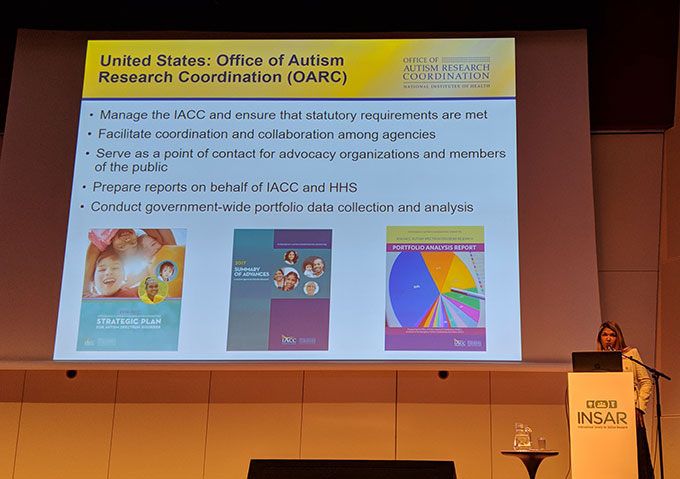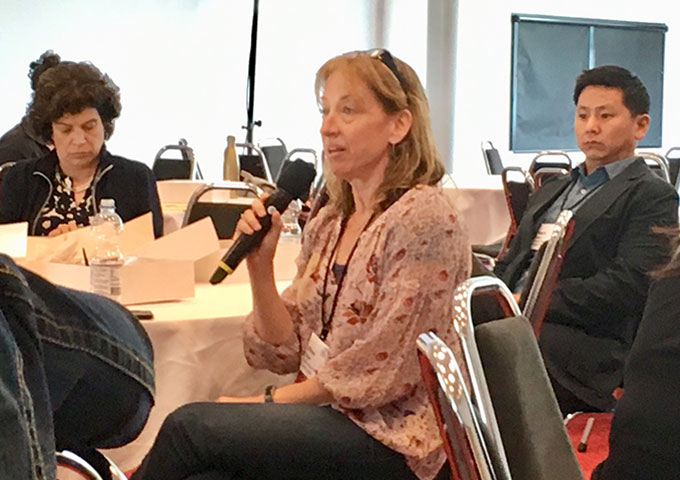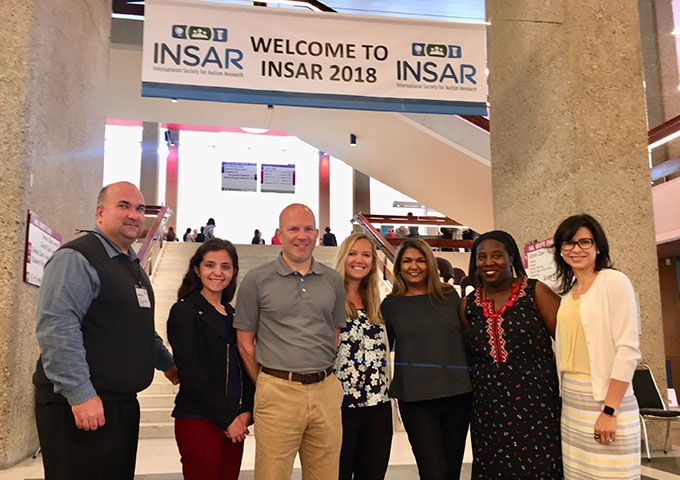
INSAR 2018 Annual Meeting
| Topic | Topic Description |
|---|---|
| Dates: | May 9-12 |
| Agenda: | The INSAR Annual Meeting (formerly IMFAR) is an annual scientific meeting, convened each spring, to exchange and disseminate new scientific progress among ASD scientists and their trainees from around the world. The aims of the meeting are:
|
| Place: |
De Doelen ICC Rotterdam Schouwburgplein 50, 3012 CL Rotterdam, Netherlands |
| Program Book: | Online Program |
| INSAR | About INSAR |

Keynote Address: Paradigm Shifts in Approaches to the Early Detection and Treatment of Autism

An International Autism Portfolio Analysis
- Slide Presentation (PDF 1 MB)
Pending 508 Compliance
G. Dawson, Department of Psychiatry and Behavioral Sciences, Duke University Medical Center, Durham, NC
Description: Over the past few decades, scientists have discovered how early brain development differs in infants and young children with autism, which has helped explain both the challenges and the strengths and abilities that are associated with autism. Furthermore, research has demonstrated the potential of early behavioral intervention to positively influence the trajectory of both behavioral and brain development in children with autism. As our understanding of the biological basis of autism increases, new treatments designed to enhance neuroplasticity and improve outcomes are currently being developed and tested. Clinical trials evaluating these new treatments are incorporating brain-based measures and quantitative, digital assessments of behavioral outcomes. Such digital approaches to behavioral assessment are transforming how we detect and understand autism and improving our ability to assess the efficacy of novel treatments.
M. T. Scott1, B. Milbourn1, M. Falkmer2, S. Bolte3, A. Halladay4, M. D. Lerner5, J. L. Taylor6 and S. J. Girdler7, (1)School of Occupational Therapy and Social Work, Curtin University, Perth, Australia, (2)Curtin University, Bentley, Australia, (3)Karolinska Institutet, Stockholm, Sweden, (4)Autism Science Foundation, New York, NY, (5)Stony Brook University, Stony Brook, NY, (6)Vanderbilt Kennedy Center, Nashville, TN, (7)School of Occupational Therapy and Social Work, Curtin University, Perth, Western Australia, Australia
Background: Adults with Autism Spectrum Disorder (ASD) demonstrate not only difficulties, but possess unique strengths and abilities which can be harnessed in the work environment often performing well in jobs requiring systematic information processing, precision and repetition. However, despite increasing recognition of the potential contribution that individuals with ASD can make in the workplace, they continue to experience challenges in finding and maintaining employment. Given that employment research in ASD is progressing there is a need to synthesize research to enable an understanding of those factors impacting employment, and a description of the targets and effectiveness of various intervention approaches. This scoping review examined the extent and range of literature relating to the employment of individuals with ASD.
Objectives: The primary objectives of this review were to: 1) comprehensively review employment literature relating to ASD and employment; 2) explore measures used in evaluating employment outcomes; 3) identify the strengths and abilities of individuals with ASD in the workplace; 4) classify and link ASD employment interventions to the International Classification of Functioning, Disability and Health (ICF) Core Sets for ASD; and 5) summarise the targets and outcomes of employment interventions.
Methods: Database searches of Medline, CINAHL, PsychINFO, Scopus, ERIC, Web of Science and EMBASE were conducted. Studies describing adults with ASD in competitive, supported or sheltered employment, the role of vocational support, or the evaluation of employment interventions were included. Data were extracted in relation to author, year of publication, country, design, participants, outcome measures and nature stage of employment. Quality of the evidence was assessed. Content analysis of results identified the strengths and abilities of employees with ASD in the workplace. Lastly, meaningful concepts relating to the evaluation of employment interventions were extracted and linked to International Classification of Functioning, Disability and Health (ICF) Core Sets for ASD.
Results: The search identified 3,701 references, of which 117 were include for review. Methodological quality of the articles ranged from limited to strong. Of the 117 articles, only 14 explored the strengths and abilities of individuals with ASD in the workplace including attention to detail, high quality of work, strong sense of morality and precise technical abilities. Thirty-two studies evaluated employment interventions for adults with ASD, primarily focusing on modifying autism-related characteristics such as social interaction, communication skills and executive functioning for improved performance in acquiring a job. While environmental factors such as technology, employer and co-worker support and job coaches were utilised in facilitating work participation, these were never the focus of interventions.
Conclusions: The ICF Core Sets for ASD enabled a holistic review of the employment literature relating to individuals with ASD. While employment interventions targeting intrinsic personal factors of adults with ASD are beneficial in improving work-related outcomes, there has been limited consideration of the role that environmental factors may play in the workplace. This review highlighted the need for the development of more holistic approaches, which consider the influence of both personal and environmental factors in improving the employment outcomes of people with ASD.
J. Harris1, Y. M. Janvier2, C. N. Coffield3, D. S. Mandell4, Z. Cidav4, M. Lopez5 and N. V. Gonzalez5, (1)Children's Specialized Hospital, Mountainside, NJ, (2)Medical, Children's Specialized Hospital, Toms River, NJ, (3)Pediatrics, Rutgers RWJ Medical School, New Brunswick, NJ, (4)University of Pennsylvania, Philadelphia, PA, (5)Autism, Children's Specialized Hospital, Fanwood, NJ
Background: Significant disparities exist in early access to care among low income and minority children at risk for ASD. These disparities may be due in part to the lack of ASD screening tools designed for this population. Existing tools typically require parents to have sophisticated reading comprehension and understanding of developmental milestones. The Developmental Check-In (DCI), a primarily visual tool with minimal literacy demands, was developed specifically for this population. Previous research with the DCI found that it outperformed the Modified Checklist for Autism in Toddlers-Revised (MCHAT-R) and Social Communication Questionnaire (SCQ) at identifying ASD among young underserved children at risk for ASD. As a next step in validating the DCI, we examined its psychometric properties in an unselected sample of young underserved children.
Objectives: To compare the performance of the DCI with that of other, validated ASD screening tools (M-CHAT-R & SCQ) in detecting ASD among an unselected sample of young underserved children.
Methods: Subjects were 24 to 60 month old children enrolled at Head Start programs, which are located in underserved communities and serve low income families. Parents completed the DCI, MCHAT-R, SCQ, medical history form, adaptive behavior measure (ABAS) and demographic information. Parents provided consent for their child’s Head Start teacher to complete the same 3 screening tools. Evaluations were offered to children at risk on any parent or teachercompleted screening tool. The children were evaluated using the Mullen Scales of Early Learning and the ADOS-2. Clinical diagnosis was determined by a licensed, experienced clinician (developmental pediatrician, psychologist or advanced practice nurse) based on patient history, clinical observation and ADOS-2 classification. Differences in performance were estimated using receiver operating characteristic curves.
Results: Completed parent-report measures were collected for 439 children. Child care providers also completed screening for 68% of the sample. Forty-one children (9%) were subsequently diagnosed with ASD. The parent-completed DCI better identified children at risk for ASD than the MCHAT-R (p<0.0001) or the SCQ (p= 0.0139). Area under the curve in the ROC analysis was 0.84, 0.67, and 0.76, respectively. For teacher-completed tools, there were no significant differences between the DCI and the MCHAT-R (p = 0.06) or SCQ (p = 0.48).
Conclusions: The parent-report version of the DCI performed better than two validated screening tools in identifying young children with ASD who were from families with low income, and/or who were non-white, Hispanic, and/or for whom English was not the primary language spoken in the home. When considered with previous findings that the DCI also performed better among young, underserved children at-risk for ASD, the DCI is a promising tool for reducing disparities in diagnosing ASD. Based on the rate of ASD (9%) among children with completed parent screens, this study also suggests that ASD screening in underserved childcare settings is a useful method for identifying children at risk.
K. L. Carpenter1, J. Lorenzi1, L. DeMoss2, H. Riehl1, E. Glenn1, L. Beyer1, J. Emerson1, K. L. Williams3, V. Smith4, H. L. Egger5, G. Baranek6 and G. Dawson7, (1)Duke Center for Autism and Brain Development, Durham, NC, (2)Rhode Island Consortium for Autism Research and Treatment, Brown University, East Providence, RI, (3)Department of Allied Health Sciences, University of North Carolina at Chapel Hill, Chapel Hill, NC, (4)Duke University, Durham, NC, (5)The Child Study Center at NYU Langone Medical Center, New York, NY, (6)Chan Division of Occupational Science and Occupational Therapy, University of Southern California, Los Angeles, CA, (7)Department of Psychiatry and Behavioral Sciences, Duke University Medical Center, Durham, NC
Background: Around 50% of individuals with autism spectrum disorder (ASD) have a comorbid anxiety disorder. Despite the fact that anxiety disorders are common and impairing in individuals with ASD, we know little about the early risk factors for anxiety in ASD, especially in the preschool period. One such risk factor is sensory over-responsivity - a set of symptoms characterized by heightened and unusual reactivity to sensory stimuli. Objectives: We conducted an in-depth study of the relationship between sensory over-responsivity and anxiety symptoms in preschool age children with ASD as compared to typically developing (TD) children.
Methods: Ninety-six 3-6 year old children (65 ASD, 31 TD) participated in this study. ASD was diagnosed using the ADOS and ADI-R by research reliable examiners. Sensory challenges were assessed via parent report using the Sensory Experiences Questionnaire v3.0 (SEQ). Anxiety disorders, including generalized anxiety disorder (GAD), separation anxiety disorder (SAD), social anxiety disorder, and specific phobia, were assessed with the Preschool Age Psychiatric Assessment (PAPA). The relationship between sensory over-responsivity and anxiety was tested with Pearson correlations. The relative odds of meeting criteria for anxiety disorders given mean sensory over-responsivity score was tested with logistic regression. In the TD group, exact logistic regression was used to account for limited sample size.
Results: Forty-six children (71%) with ASD and 11 TD children (35%) met both symptom and impairment criteria for at least one anxiety disorder. Further, 39 children (60%) with ASD and 4 TD children (13%) fell 2SDs above typically developing norms for sensory over-responsivity. Overall, there was a significant correlation between mean sensory over-responsivity score and number of anxiety symptoms in all children (r2=0.68, p<0.0001), as well as in both groups separately (ASD: r2=0.60, p<0.0001; TD: r2=0.44, p=0.01). This relationship translated into a 5-fold increased chance of anxiety in children with high levels of sensory over-responsivity in the ASD group (OR 5.5, 95% CI: 1.72, 17.56, p<0.01) and a 7-fold increase in the TD group, though it was not statistically significant in the TD group (OR 7.1, 95% CI: 0.64, 79.24, p=0.1). In the ASD group, sensory over responsivity significantly increased the odds of GAD by a factor of 6 (OR 6.6, 95% CI: 1.69, 25.55, p<0.01) and SAD by a factor of 3 (OR 3.6, 95% CI: 1.26, 10.32, p=0.02). In the TD group, sensory over responsivity increased the odds of SAD by a factor of 15 (OR 14.96, 95% CI: 0.952, 942.9 p=0.056), but was not associated with other types of anxiety.
Conclusions: Results suggest sensory over-responsivity is strongly associated with anxiety disorders in preschoolers with ASD, as well as TD preschoolers. In preschoolers with ASD, sensory over-responsivity is associated with both GAD and SAD. In TD preschoolers, preliminary results suggest it is associated with SAD only. Identifying early child characteristics, such as sensory over-responsivity, that confer risk for anxiety may set the stage for the development of targeted treatment strategies that can reduce or prevent anxiety before it emerges in young children.
J. McPartland1, S. J. Webb2, F. Shic3, A. Naples1, C. Sugar4, M. Murias5, J. Dziura6, C. Brandt6, R. Bernier2, K. Chawarska1, G. Dawson7, S. Faja8, S. Jeste4 and C. A. Nelson8, (1)Child Study Center, Yale University School of Medicine, New Haven, CT, (2)Psychiatry and Behavioral Sciences, University of Washington, Seattle, WA, (3)Center for Child Health, Behavior and Development, Seattle Children's Research Institute, Seattle, WA, (4)University of California, Los Angeles, Los Angeles, CA, (5)Duke University, Durham, NC, (6)Yale University, New Haven, CT, (7)Department of Psychiatry and Behavioral Sciences, Duke University Medical Center, Durham, NC, (8)Boston Children's Hospital, Boston, MA
Background: Recent scientific advances offer promise for the development of targeted treatment methods to improve social-communication in autism spectrum disorder (ASD). The promise of targeted treatments is hindered by a lack of reliable and sensitive objective measures to identify subgroups likely to respond to specific treatments, to rapidly assess response to treatment, and to evaluate whether a treatment has affected the intended target. The Autism Biomarkers Consortium for Clinical Trials is a multisite biomarker development study designed to advance these objectives.
Objectives: The goals of the ABC-CT are to: (1) establish sensitive and reliable objective EEG, eye-tracking (ET), and lab-based behavioral assays of social communication in ASD for predicting and quantifying response to treatment, reducing heterogeneity of samples via stratification, indicating early efficacy, and demonstrating target engagement; (2) create a publicly accessible repository spanning genetics, biomarkers, and clinical and behavioral information; and (3) establish an infrastructure optimized for the conduct of future clinical trials.
Methods: Prior to commencing full-scale data collection, a feasibility study assessed 51 subjects (25 ASD, 26 TD) to ensure: standardization and viability of data collection across sites; valid and reliable implementation of experimental measures; effectiveness of data processing, extraction, and quality control procedures; and reliability of data management, upload, and sharing systems. The main study commenced in October 2016 and will include 200 rigorously characterized children with ASD (6-11 years; IQ 60-150) and 75 typically developing (TD) control subjects at three time points (Baseline, 6 weeks, 24 weeks). Detailed manuals of procedures (MOPs) and identical biomarker acquisition hardware and software are intended to minimize variance in ascertainment across sites, and clinical characterization is standardized with a clinical MOP and regular teleconferences to ensure reliability. A unique study governance brings together diverse expertise to facilitate progress from discovery to biomarker qualification. To provide opportunity for confirming biomarker results in independent samples, several EEG and ET paradigms are harmonized with those utilized in EU-AIMS.
Results: Results: As of October 2017, 203 participants have been enrolled in the main study, with 181 having reached 6 week visits and 116 having reached 24 week visits. Data acquisition procedures have been highly successful, with valid data acquisition rates above 96% across biomarker data modalities, and longitudinal attrition has been minimal (N=15). Panels in this symposium will report data from the interim analysis sample, at which point approximately half of the main study sample will have completed a 6 week visit. Interim analyses will focus on preliminary evaluation of biomarkers for clinical trials, in terms of acquisition and psychometric properties, as well as utility for stratification, discrimination, and indicating clinical status.
Conclusions: The ABC-CT, and other consortia like it, are advancing the goal of clinically practicable biomarkers by investigating well-evidenced biomarkers in large, well-characterized cohorts in the context of a longitudinal design. Progress in these studies is laying groundwork for more sensitive and reliable measurement in clinical trials, and the use of economical and scalable biomarker technologies holds promise for eventual deployment in a broader range of clinical and research contexts.
S. R. Crabbe1, B. B. Maddox2 and D. S. Mandell1, (1)University of Pennsylvania, Philadelphia, PA, (2)Psychiatry, Center for Mental Health Policy and Services Research, University of Pennsylvania, Philadelphia, PA
Background: The number of adults diagnosed with autism is growing. More than half have a co-occurring psychiatric disorder, with anxiety and depression being the most common (Buck et al., 2014). In the general population, especially for those with public insurance, these disorders are typically treated at local community mental health centers (CMHCs). Many adults with autism would benefit from mental health treatment, but do not access these services, often because there are few clinicians trained to work with them. There is limited literature exploring this topic, and examining clinician perspectives on training needs would shed light on specific strategies to increase the quality services available to adults with autism. This study is the first to directly interview mental health clinicians on their experiences and needs in regards to treating adults with autism.
Objectives: This community partnered study aims to identify the barriers clinicians in CMHCs face in providing quality services to adults with autism. These results will directly inform the development of a training program for CMHC clinicians.
Methods: To date, 28 clinicians (86% female, 76% white) from six CMHCs have completed a semi-structured interview. Participants were psychotherapists, case managers and intake coordinators. The interview contained questions about their knowledge of autism symptoms in adults, experience with and confidence in treating adults with autism, prior education and training related to adults with autism, and recommendations for topics that related training should address. All interviews were audio recorded and transcribed professionally for analysis. The analysis will be guided by grounded theory.
Results: Data collection and analyses are ongoing and will be completed by February 2018. While some clinicians noted that they had provided services to a handful of adults with autism, many did not have any experience treating this population. Most participants had no training or education in treating adults with autism and could only describe a few autism symptoms. Many clinicians were open to working with adults with autism, but lacked confidence to provide proper treatment due to inadequate knowledge about effective strategies for this population. For example, one clinician noted during her experience providing therapy to an adult with autism, “I was asking him the wrong questions or I was saying things in a way that I wasn't communicating or getting through to him. So it was challenging for me and…probably frustrating for the client.
Conclusions: Many CMHC clinicians do not have the confidence or skills to effectively address the needs of adults with autism. Clinicians could be better equipped to do so with the right training. From their perspective, priority training needs include a deeper understanding of core autism symptoms and how those affect the therapeutic relationship, along with direction on modifying treatment strategies for adults with autism. Clinicians would be interested in participating in an interactive training program, preferably with involvement from adults with autism, role-play exercises, discussion of actual cases, and ongoing consultation. Clinician training would increase their competence and confidence to provide needed services that will enhance the quality of life of adults with autism.
S. Daniels1, J. Rava2, J. Cusack3 and G. Warner4, (1)National Institute of Mental Health (NIMH), Rockville, MD, (2)National Institute of Mental Health, Office of Autism Research Coordination (OARC), Rockville, MD, (3)Autistica, London, United Kingdom of Great Britain and Northern Ireland, (4)Autistica, London, United Kingdom
Background: In this talk, the Office of Autism Research Coordination (OARC) of the U.S. National Institutes of Health (NIH), Autistica of the U.K., and the Canadian Government will present findings from a ground-breaking International Portfolio Analysis that describes autism research investments spanning government and private funders in the U.S., U.K., and Canada. OARC/NIH manages the Interagency Autism Coordinating Committee (IACC) a federal advisory body that provides advice to the U.S. government on issues related to ASD. OARC conducts an annual portfolio analysis of U.S. research projects to help guide the IACC’s strategic planning efforts. Autistica is the national autism research charity in the UK. The Canadian Institutes of Health Research (CIHR) Institute of Neurosciences, Mental Health and Addiction (INMHA) supports research on biomedical, clinical, health services, and population research related to the neurosciences, mental health, and addiction. These three international partners collected and analyzed data from research projects funded by government and private funders in their respective countries and analyzed it according to the seven general categories of research described in the IACC Strategic Plan for ASD.
Objectives: By taking an international perspective centered on universal research topic areas, the portfolio analysis presented in this talk should improve knowledge of international research efforts in the seven research areas adapted from the IACC Strategic Plan and identify potential gaps or areas of opportunity for future research endeavors and collaborations. The international partners plan to continue the analysis as an annual exercise and aim to encourage participation from more countries to demonstrate global progress in the field of autism research.
J. L. Taylor1, L. E. Smith DaWalt2, S. Odom3, K. Hume4, B. Kraemer5 and L. J. Hall5, (1)Vanderbilt Kennedy Center, Nashville, TN, (2)Waisman Center- University of Wisconsin, Madison, WI, (3)University of North Carolina, Chapel Hill, NC, (4)University of North Carolina, Chapel HIll, Carrboro, NC, (5)Special Education, San Diego State University, San Diego, CA
Background: Women with autism spectrum disorder (ASD) have a more difficult time than men maintaining post-secondary employment/educational positions, though they obtain these positions at similar rates. One hypothesized explanation for this difference is that social deficits associated with ASD have a greater impact on the day-to-day functioning of women with ASD, given that social behavior is generally more important for societal interactions of females versus males. The present study explores this hypothesis in a sample of high school-aged students with ASD.
Objectives: This study has two objectives: 1) to test for sex differences in parent- and teacher-reported autism symptoms; and 2) to examine sex differences in patterns of social interactions for high school students with ASD.
Methods: Participants include 547 adolescents (76 Females, 471 Males) between 13 and 20 (M=16.2, SD=1.4), who all have an educational diagnosis of ASD and are part of a larger longitudinal study of 60 high schools in 3 states (CA, NC, WI). The sample was diverse with 45.7% of students being from a racial or ethnic minority group. Parent-reported lifetime autism symptoms were assessed using the Social Communication Questionnaire. Teacher-reported current autism symptoms were measured using the Social Responsiveness Scale-II. Parents and teachers answered questions regarding the student with ASD’s social behavior, including how frequently they interacted with typically-developing and disabled peers in schools, and how often they interacted with peers outside of school by phone, over the internet, and in person.
Results: Analysis of variance was used to test for sex differences in autism symptoms and social participation. Although parents rated lifetime autism symptoms as nearly identical for males versus females (M=20.67, SD=7.66 for males; M=21.15, SD=7.42 for females), F=0.20, p=.65, teachers rated autism symptoms as more severe in the females (M=69.18, SD=11.13 for males; M=78.00, SD=15.84 for females), F = 33.33, p < .001. Sex differences were also noted in some aspects of social participation – both in and out of school. Teachers reported that females spent a greater percentage of time compared to males interacting with typically-developing peers, F=7.76, p<.01, although there were no sex differences in percentage of time interacting with peers with disabilities, F=3.25, p=.07. Despite more time interacting with peers without disabilities, females were no more likely than males to have a single person that they interacted with at least 5 times in a week (a regular social partner), F=.79, p=.375. Outside of school, females were more likely than males to interact with peers using technology (e.g., calling/texting/internet), F=6.87, p < .01, but there were no sex differences in in-person interactions with peers (e.g., getting together with friends outside of school), F=2.40, p=.12
Conclusions: Discussion will touch on possible explanations for discrepancies in teacher versus parent findings on sex differences in autism symptom severity, including: 1) autism symptoms that become less severe over time for males versus females (lifetime versus current symptoms); and 2) similar symptom presentations that appear more impairing in females due to societal expectations or unsuccessful peer interactions.
J. K. Lee1, B. Heath2, A. L. Hechtman2, C. Gohring3, K. Huynh3, D. G. Amaral2, S. Ozonoff2 and C. W. Nordahl2, (1)Psychiatry and Behavioral Sciences, University of Califnornia, Davis, MIND Institute, Sacramento, CA, (2)Psychiatry and Behavioral Sciences, University of California at Davis, MIND Institute, Sacramento, CA, (3)UC Davis MIND Institute, Sacramento, CA
Background: Sex differences in the neuropathology of autism spectrum disorder (ASD) are currently poorly understood. While prior research reported sex and ASD related differences in diffusion properties and organization of the corpus callosum in pre-school age children (Nordahl et al., 2015), these interhemispheric connectivity differences have not been examined using resting-state functional magnetic imaging (rfMRI). Objectives: The current research examines sex-differences in interhemispheric resting state functional connectivity in preschool aged children with and without ASD, and how individual differences ASD symptom severity relates to interhemispheric connectivity. Methods: The sample included 119 children with ASD (86 male, 33 female) and 68 age-matched typically developing (TD) controls (40 male, 28 female) (mean age 3.7 years). Diagnostic assessments for ASD were carried out by expert clinicians using the ADOS and ADI-R. Structural and resting state EPI BOLD images were acquired during natural nocturnal sleep. Resting state images were preprocessed using tools from AFNI, FSL, and ANTS in the Configurable Pipeline for the Analysis of Connectomes (C-PAC; Craddock et al., 2013). In brief, EPI images were time-shifted, motion corrected, and bandpass filtered (.008 < f < .08 Hz). Volumes with frame-wise displacement greater than 0.25mm were scrubbed. EPIs were then co-registered to the participant’s structural T1-weighted image and then to symmetric MNI space, and smoothed at 6 mm FWHM. Interhemispheric connectivity was assessed using voxel-mirrored homotopic connectivity (VMHC). Cluster based correction for multiple comparisons was carried out using Gaussian Random Field theory using FSL (Z >2.58, pGRF <.05). For each interaction cluster, mean interhemispheric connectivity was extracted for each participant to test simple effects and slopes; reported p-values for these tests are adjusted for multiple comparisons using Bonferroni.
Results: Preliminary results reveal atypical interhemispheric functional connectivity in both boys and girls with ASD. Both males and females with ASD exhibit decreased interhemispheric connectivity between left and right posterior cingulate and precuneus cortices relative to TD (p = .01), with a cluster in the precuneus exhibiting a larger decrease in ASD males relative to TD males than do ASD females relative to TD females (Interaction: p = 1.0e-4). Reductions in interhemispheric connectivity relative to TD were also observed in paracingulate cortex and frontal operculum in males (ps ≤ .002). Greater ADOS severity scores predict greater interhemispheric connectivity in the cerebellum in females (b = .12, p = .048), but not males (b = -.07, p = .12), (interaction: p = .006). Greater ADOS severity scores predict decreased interhemispheric connectivity in two clusters in precuneus and superior temporal gyrus in males (bs = ≤ -.07, ps ≤ .001), but positively in the middle temporal gyrus for females (b = .08, p = .03) (interactions: ps ≤ 3.1e-5). These results suggest that the neural phenotype of ASD in young children is differentially presented in males and females compared to their respective typically developing peers.
Conclusions: These preliminary data suggest that females and males with ASD have partially dissimilar patterns of interhemispheric functional connectivity.
D. Yang1,2, A. Jack1, P. E. Ventola3, E. H. Aylward4, M. Dapretto5, D. Geschwind5, J. S. Duncan6, G. L. Wallace1, S. J. Webb7, S. Y. Bookheimer5, L. Kenworthy8, C. Torgerson9, Z. Jacokes9, C. A. Nelson10, J. Van Horn9, T. Girls’ Neurogenetics Network Team1 and K. Pelphrey1, (1)The George Washington University, Washington, DC, (2)Children's National Medical Center, Washington, DC, (3)Yale Child Study Center, Yale University School of Medicine, New Haven, CT, (4)Seattle Children's Research Institute, Seattle, WA, (5)University of California, Los Angeles, Los Angeles, CA, (6)Biomedical Engineering/Radiology, Yale University, New Haven, CT, (7)Psychiatry and Behavioral Sciences, University of Washington, Seattle, WA, (8)Children's National Medical Center, Rockville, DC, (9)University of Southern California, Los Angeles, CA, (10)Boston Children's Hospital, Boston, MA
Background: Autism Spectrum Disorders (ASD) disproportionately affect males over females. Our NIH Autism Center of Excellence Girls’ Neurogenetics Network has contributed to understanding this bias at the levels of gene structure and expression, neural dynamics, brain function, and connectivity. The skew may be explained in part via mechanisms that confer a Female Protective Effect (FPE), combined with normative sexually dimorphic brain development, environmental factors, and potential measurement biases. This work is important because characterizing the FPE may help illuminate and treat ASD in both sexes.
Objectives: We sought to model and evaluate cortical thickness in males and females with ASD and age-, sex-, and cognitive-ability matched typically developing (TD) comparison participants.
Methods: The sample included 219 children and adolescents (age: M = 13.01y, SD = 2.91y, range = 8.03-17.99y; IQ: M = 107.50, SD = 17.87, range = 75- 167) recruited from four research sites (Yale, Harvard, UCLA, Seattle). There were 54 ASD females, 52 TD females, 59 ASD males and 54 TD males. The four groups were well-matched on age and IQ. Females (F) and males (M) with ASD were well-matched on ASD symptom severity, language ability and adaptive behaviors. F-ASD and F-TD were well-matched on intracranial volume (ICV), so were M-ASD and M-TD. All participants underwent a T1-weighted structural scan. Cortical thickness was estimated using FreeSurfer v6.0.0 and fwhm=15mm. Quality of the structural MRI images were independently rated by two researchers, blind to group membership; 30 subjects (6 F-ASD, 5 F-TD, 17 M-ASD, 2 M-TD) exhibiting obvious head motion were discarded. Age was centered before entered into analysis. Results were thresholded at Z>1.96 (vertex-level) and p<.05 (cluster-level) (two-sided), while site, IQ, and ICV were included as covariates of no interest.
Results: The analysis showed that across all participants, as expected, there were widespread age-related reductions in cortical thickness during this developmental epoch. In males, the whole-brain analysis revealed a significant Age × Diagnosis interaction localized to the right pSTS and nearby regions as outlined in Figure 1. However, in girls, there were no surviving regions across the whole brain showing a significant Age × Diagnosis interaction, while the Age × Diagnosis interaction in the outlined region was not significant in girls, p=.21. Finally, the 3-way Age × Diagnosis × Sex interaction effect in the outlined region was significant, p=.04, partial η2 = .024. The scatterplots are also presented for this region.
Conclusions: Consistent with prior, published reports, males with ASD relative to same-sex TD exhibit accelerated age-related cortical thinning specifically in the right pSTS region during late childhood and adolescence. However, this atypicality is not present in girls with ASD. These findings suggest evidence for one of the developmental brain differences underlying the FPE in ASD.
E. McGhee Hassrick1, W. I. Shih2, C. Friedman3, Z. Shamsi4, S. F. Vejnoska5, B. Bronstein6, D. Linares7, K. M. Carley8, A. C. Stahmer9, T. Smith10, P. Mundy11, D. S. Mandell6 and C. Kasari12, (1)Drexel University A.J. Drexel Autism Institute, Philadelphia, PA, (2)University of California, Los Angeles, Los Angeles, CA, (3)Drexel University, Philadelphia, PA, (4)Drexel University, Phialdelphia, PA, (5)University of California, Davis, Sacramento, CA, (6)University of Pennsylvania, Philadelphia, PA, (7)Health Resources and Services Administration, Rockville, MD, (8)Carnegie Mellon University, Pittsburg, PA, (9)Psychiatry and Behavioral Sciences, University of California at Davis MIND Institute, Sacramento, CA, (10)University of Rochester Medical Center, Rochester, NY, (11)University of California at Davis, Sacramento, CA, (12)University of California Los Angeles, Los Angeles, CA
Background: Parents and providers face challenges preparing children with ASD for school transitions (Boyd, McDowall, & Cooper, 2002; Tehee, Honan, & Hevey, 2009). Social relationships among a child’s key supporters could provide important resources to improve transition success. Social network analysis offers powerful ways to examine dimensions ofthese relationships such as sharing and problem-solving (Fischer 1982; Rodrique et al 1990; Laumann and Pappi 1976; Breiger 1981). Network approaches have been applied in studies of health or health behavior (Bearman & Moody 2004; Bearman, Moody & Stovel 2004; Christakis & Fowler 2007, 2008; Coleman, Elihu & Menzel 1966) as well as health information-seeking (Colon-Ramos et al 2009) and communication and decision-making among health care personnel (Creswick, Westbrook & Braithwaite 2009; Fattore et al 2009; Scott et al 2005). Our study tests associations between structural dimensions of social relationships and transition success for children with ASD, thereby informing systematic attempts to improve school transitions for these children.
Objectives: Use ego-centric social network techniques to test the association between the perception of transition success and different types of social relationships, including instrumental relationships such as problem-solving networks and affective relationships such as trust networks. We test the hypothesis that problem solving networks and trust networks among home/school/community care providers are associated with perceptions of transition success.
Methods: 47 participants completed social network interviews, conducted 6 weeks before the end of the child’s school year at the old school, including 8 parents and 39 providers. We interviewed key participants using the SoDI: The Social Dynamics of Intervention Measure (McGhee Hassrick et al 2018; McGhee Hassrick and Carley 2015), where each participant reported frequency of problem solving and degree of trust for each person on the team roster. Using ORA network analysis software (Carley et al 2004), we computed egocentric problem solving and trust measures for each participant, including indegree (# of team members who seek out the participant), out-degree (# of team members that the participant seeks out) and eigenvector centrality (degree of connectivity that the participant had with well-connected team members). Participants also rated perceived transition success on a 5-point Likert scale, where 1 = not successful and 5 =very successful. We used OLS regression to test associations between our outcome measure of perceived transition success and our egocentric network predictor variables.
Results: Perceived transition success was positively and modestly associated with out-degree centrality in trust networks, positively and significantly associated with eigenvalue centrality in trust networks and negatively associated with in-degree centrality in trust networks. It was also positively associated with indegree, outdegree and eigenvector centrality in problem solving networks, but these associations were not significant.
Conclusions: Trust was an important predictor for transition success. When participants trusted team members who themselves where highly trusted, their perception of the child’s transition success was significantly higher. This finding suggests that building trust for key leaders on a child’s team might increase the perception of transition success.
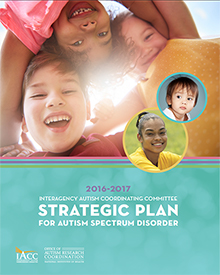
IACC Strategic Plan for Autism Spectrum Disorder
- Provides guidance to federal agencies and partner private organizations regarding ASD research and services priorities, knowledge gaps, and goals.
- Describes the latest updates on research and services organized around seven Strategic Plan question areas.
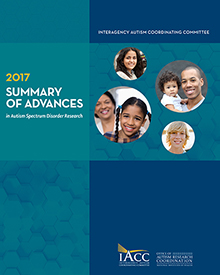
IACC Summary of Advances in ASD Research
- Provides short, plain language summaries of the top 20 research articles selected by the IACC.
- The studies selected for 2017 have provided new insight into potential biomarkers to predict risk of autism spectrum disorder (ASD), developmental trajectories of children with ASD, and the impact of the various prenatal exposures on ASD risk.








